operating fault messages RENAULT CAPTUR 2017 1.G Owners Manual
[x] Cancel search | Manufacturer: RENAULT, Model Year: 2017, Model line: CAPTUR, Model: RENAULT CAPTUR 2017 1.GPages: 248, PDF Size: 6.56 MB
Page 57 of 248
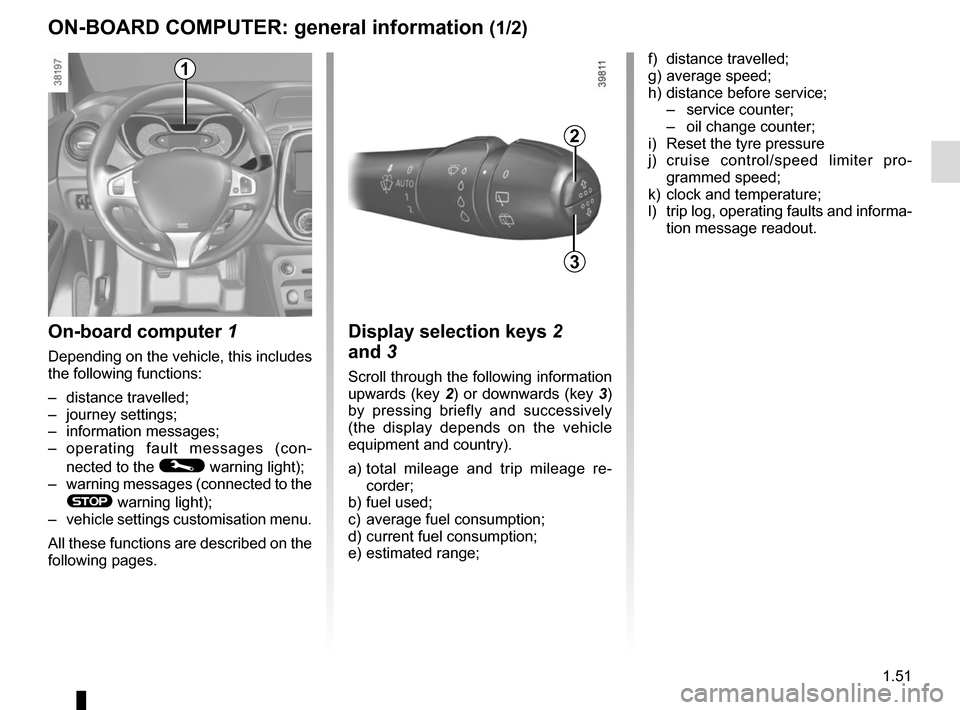
1.51
ON-BOARD COMPUTER: general information (1/2)
On-board computer 1
Depending on the vehicle, this includes
the following functions:
– distance travelled;
– journey settings;
– information messages;
– operating fault messages (con-
nected to the
© warning light);
– warning messages (connected to the
® warning light);
– vehicle settings customisation menu.
All these functions are described on the
following pages.
Display selection keys 2
and 3
Scroll through the following information
upwards (key 2) or downwards (key 3)
by pressing briefly and successively
(the display depends on the vehicle
equipment and country).
a) total mileage and trip mileage re-
corder;
b) fuel used;
c) average fuel consumption;
d) current fuel consumption;
e) estimated range;
2
3
f) distance travelled;
g) average speed;
h) distance before service;
– service counter;
– oil change counter;
i) Reset the tyre pressure
j) cruise control/speed limiter pro- grammed speed;
k) clock and temperature;
l) trip log, operating faults and informa- tion message readout.1
Page 63 of 248
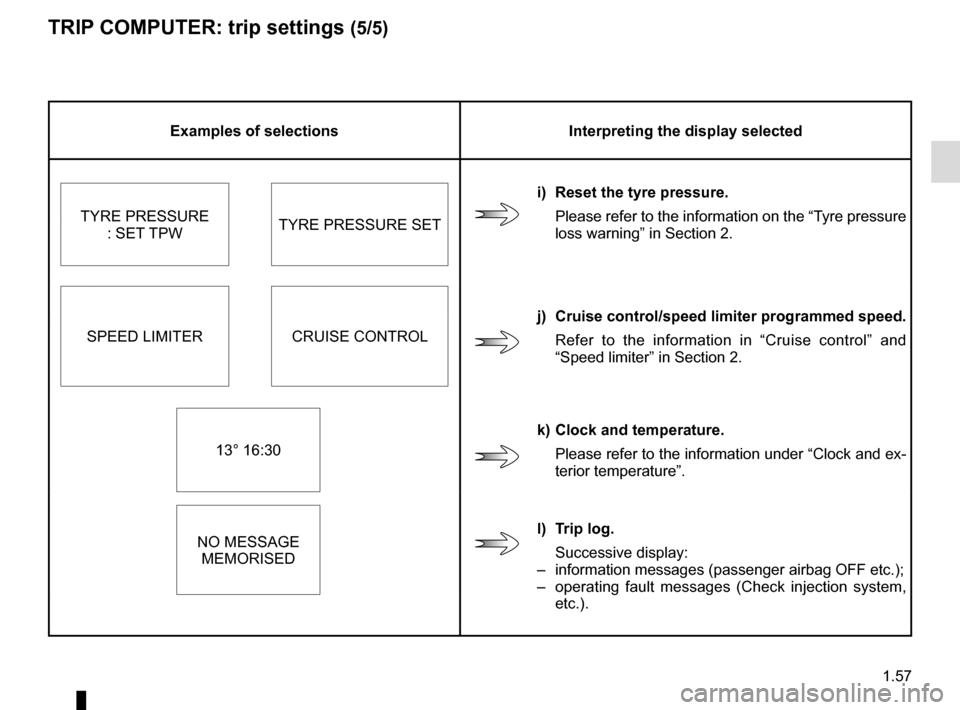
1.57
TRIP COMPUTER: trip settings (5/5)
Examples of selectionsInterpreting the display selected
i) Reset the tyre pressure. Please refer to the information on the “Tyre pressure
loss warning” in Section 2.
TYRE PRESSURE
: SET TPW TYRE PRESSURE SET
SPEED LIMITER CRUISE CONTROL j) Cruise control/speed limiter programmed speed.
Refer to the information in “Cruise control” and
“Speed limiter” in Section 2.
13° 16:30 k) Clock and temperature.
Please refer to the information under “Clock and ex-
terior temperature”.
NO MESSAGE MEMORISED l) Trip log.
Successive display:
– information messages (passenger airbag OFF etc.);
– operating fault messages (Check injection system,
etc.).
Page 65 of 248
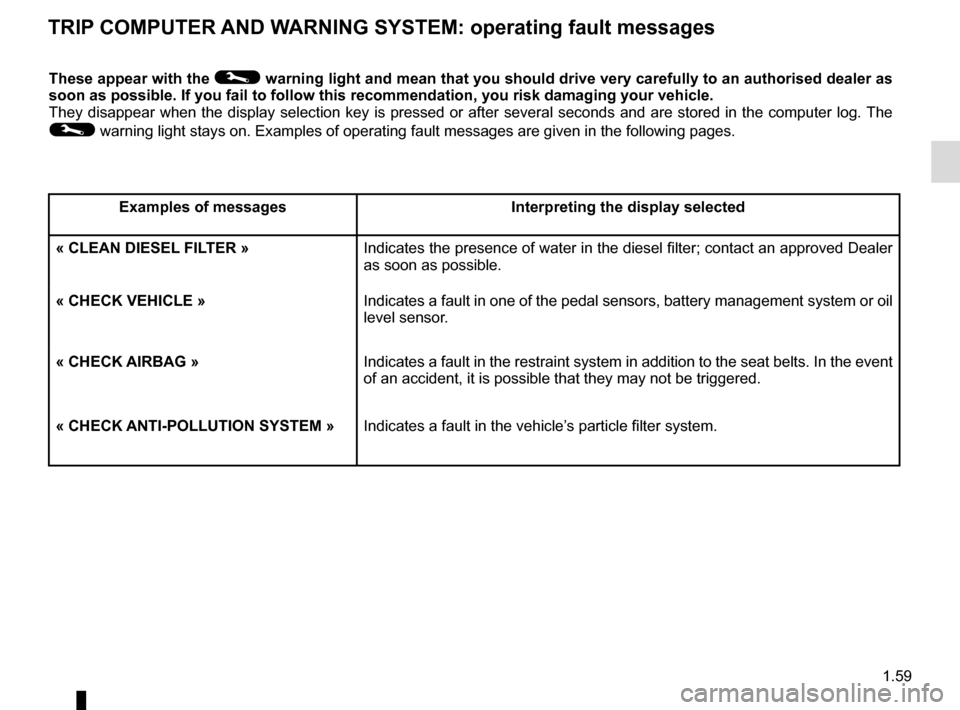
1.59
TRIP COMPUTER AND WARNING SYSTEM: operating fault messages
These appear with the © warning light and mean that you should drive very carefully to an author\
ised dealer as
soon as possible. If you fail to follow this recommendation, you risk da\
maging your vehicle.
They disappear when the display selection key is pressed or after severa\
l seconds and are stored in the computer log. The
© warning light stays on. Examples of operating fault messages are given \
in the following pages.
Examples of messages Interpreting the display selected
« CLEAN DIESEL FILTER » Indicates the presence of water in the diesel filter; contact an approve\
d Dealer
as soon as possible.
« CHECK VEHICLE » Indicates a fault in one of the pedal sensors, battery management system\
or oil
level sensor.
« CHECK AIRBAG » Indicates a fault in the restraint system in addition to the seat belts.\
In the event
of an accident, it is possible that they may not be triggered.
« CHECK ANTI-POLLUTION SYSTEM » Indicates a fault in the vehicle’s particle filter system.
Page 109 of 248
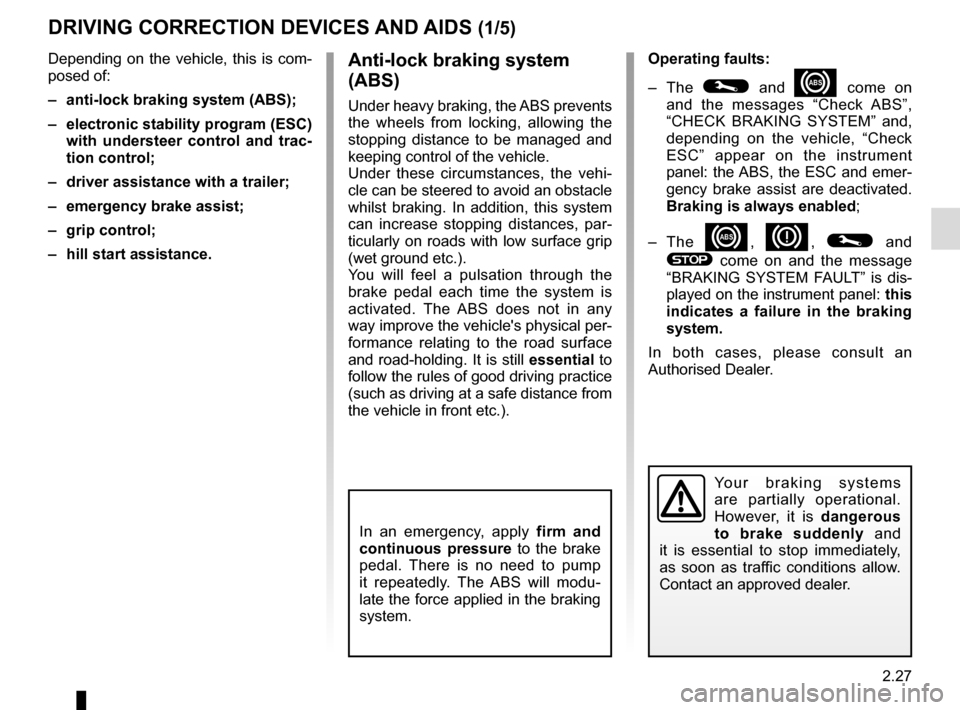
2.27
DRIVING CORRECTION DEVICES AND AIDS (1/5)
Anti-lock braking system
(ABS)
Under heavy braking, the ABS prevents
the wheels from locking, allowing the
stopping distance to be managed and
keeping control of the vehicle.
Under these circumstances, the vehi-
cle can be steered to avoid an obstacle
whilst braking. In addition, this system
can increase stopping distances, par-
ticularly on roads with low surface grip
(wet ground etc.).
You will feel a pulsation through the
brake pedal each time the system is
activated. The ABS does not in any
way improve the vehicle's physical per-
formance relating to the road surface
and road-holding. It is still essential to
follow the rules of good driving practice
(such as driving at a safe distance from
the vehicle in front etc.).
In an emergency, apply firm and
continuous pressure to the brake
pedal. There is no need to pump
it repeatedly. The ABS will modu-
late the force applied in the braking
system.
Your braking systems
are partially operational.
However, it is dangerous
to brake suddenly and
it is essential to stop immediately,
as soon as traffic conditions allow.
Contact an approved dealer.
Depending on the vehicle, this is com-
posed of:
– anti-lock braking system (ABS);
– electronic stability program (ESC) with understeer control and trac-
tion control;
– driver assistance with a trailer;
– emergency brake assist;
– grip control;
– hill start assistance. Operating faults:
– The
© and x come on
and the messages “Check ABS”,
“CHECK BRAKING SYSTEM” and,
depending on the vehicle, “Check
ESC” appear on the instrument
panel: the ABS, the ESC and emer-
gency brake assist are deactivated.
Braking is always enabled;
– The
x, D, © and
® come on and the message
“BRAKING SYSTEM FAULT” is dis-
played on the instrument panel: this
indicates a failure in the braking
system.
In both cases, please consult an
Authorised Dealer.
Page 243 of 248
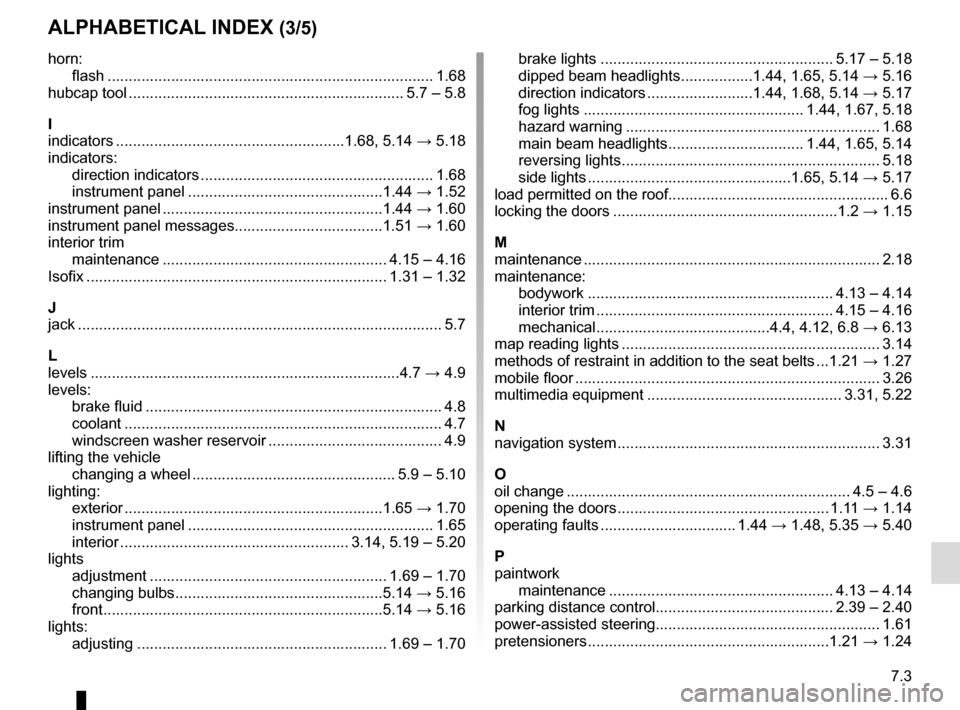
7.3
ALPHABETICAL INDEX (3/5)
horn:flash ..................................................................\
........... 1.68
hubcap tool ................................................................. 5.7 – 5.8
I
indicators ......................................................1.68, 5.14 → 5.18
indicators: direction indicators ....................................................... 1.68
instrument panel ..............................................1.44 → 1.52
instrument panel ....................................................1.44 → 1.60
instrument panel messages...................................1.51 → 1.60
interior trim maintenance ..................................................... 4.15 – 4.16
Isofix ....................................................................... 1.31 – 1.32
J
jack ...................................................................\
................... 5.7
L
levels .................................................................\
........4.7 → 4.9
levels: brake fluid ...................................................................... 4.8
coolant ................................................................\
........... 4.7
windscreen washer reservoir ......................................... 4.9
lifting the vehicle changing a wheel ................................................ 5.9 – 5.10
lighting: exterior .............................................................1.65 → 1.70
instrument panel .......................................................... 1.65
interior ...................................................... 3.14, 5.19 – 5.20
lights adjustment ........................................................ 1.69 – 1.70
changing bulbs .................................................5.14 → 5.16
front ..................................................................\
5.14 → 5.16
lights: adjusting ........................................................... 1.69 – 1.70 brake lights ....................................................... 5.17 – 5.18
dipped beam headlights .................1.44, 1.65, 5.14
→ 5.16
direction indicators .........................1.44, 1.68, 5.14 → 5.17
fog lights .................................................... 1.44, 1.67, 5.18
hazard warning ............................................................ 1.68
main beam headlights ................................ 1.44, 1.65, 5.14
reversing lights ............................................................. 5.18
side lights ................................................1.65, 5.14 → 5.17
load permitted on the roof.................................................... 6.6
locking the doors .....................................................1.2 → 1.15
M
maintenance ............................................................\
.......... 2.18
maintenance: bodywork .......................................................... 4.13 – 4.14
interior trim ........................................................ 4.15 – 4.16
mechanical .........................................4.4, 4.12, 6.8 → 6.13
map reading lights ............................................................. 3.14
methods of restraint in addition to the seat belts ...1.21 → 1.27
mobile floor ........................................................................\
3.26
multimedia equipment .............................................. 3.31, 5.22
N
navigation system .............................................................. 3.31
O
oil change ................................................................... 4.5 – 4.6
opening the doors .................................................. 1.11 → 1.14
operating faults ................................ 1.44 → 1.48, 5.35 → 5.40
P
paintwork maintenance ..................................................... 4.13 – 4.14
parking distance control.......................................... 2.39 – 2.40
power-assisted steering..................................................... 1.61
pretensioners .........................................................1.21 → 1.24